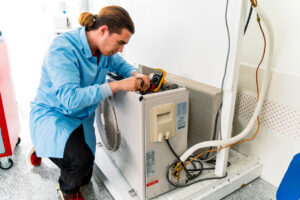According to the National Fire Protection Association, there were around 370,000 fires in homes in the United States in 2013 due to lack of fire safety measures. Some of these fires resulted in serious injury and even death to the homes’ occupants, and others caused costly property damage.
Some fires may have not been preventable, such as those caused by lightning that struck the home. Others may have been prevented, such as those caused by carelessness with burning candles, cigarettes and other related items.
Because fires can quickly rage out of control and cause serious injury or death, it is important for individuals to understand how to prevent fires in the home and to ensure that they are prepared to take action if a fire does occur.
Fire Prevention and Safety Features in the Home
All homes should have one or more functional smoke alarms. Smoke alarms are generally battery-operated devices that are placed on a ceiling or the upper section of the wall, and they emit a very loud sound when they detect smoke in the home. They notify the home’s occupants that a fire is in the home so that they can immediately evacuate and call emergency fire crews for assistance.
It is ideal to place a smoke alarm on every floor of the home, and for the maximum level of safety, these alarms should be placed in or near every bedroom in the home. This makes it more likely for those who are sleeping in the home to be awoken by the sound of the alarm. These alarms should be tested each month to ensure that the batteries are still active. Even if the batteries are effective, you should replace the batteries every six months as a safety precaution. When inspecting or replacing the batteries, take steps to remove the dust from the sensor on the fire alarm.
In addition, you should also have a fire extinguisher available in the home. Most commonly, a fire extinguisher is stored under the kitchen sink in a home because many fires commonly develop in the kitchen with food preparation activities. It may be wise to keep a fire extinguisher on every level of the home so that one is always easily accessible.
Keep in mind that you should also know how to use the fire extinguisher. The time to read usage instructions on the fire extinguisher’s label is before a fire breaks out rather than after. For example, you should aim the extinguisher at the base of the fire rather than at the top of the flames.
Identifying Potential Fire Risks
These steps can help you to prepare for the possibility of a fire breaking out in your home, but you can also take steps to prevent fires. Not every type of home fire is preventable, but many are.
Electrical issues are a common cause of home fires, and some of these fires can be prevented by simply unplugging appliances when they are not in use. In addition, you should inspect your electrical cords regularly for signs of damage. Damaged electrical cords should never be used until the damage has been repaired. In addition, electrical cords should not be placed under carpeting or furniture.
In addition to electrical fires, other fires develop through cooking practices. When cooking, avoid wearing loose-fitting clothing that could accidentally fall into an open flame. Kids and pets should be allowed to play next to an open flame on a stove.
Furthermore, you should take time to learn how to deal with a grease fire. For example, you should never pour water on a grease fire as this can actually fuel the flame. Instead, covering the fire with a pot lid may be a more effective way to put the flame out.
Dealing With Highly Flammable or High-Risk Substances
Electrical fires and cooking fires may be two of the most common sources of home fires, but there are other potential dangers in and around a typical home as well. For example, some substances that are highly flammable may be stored on-site. These substances include oil-soaked rags, paint and even gas that is used for a lawn mower or other lawn maintenance equipment.
These items should be stored in a manner specified on the safety label. If a safety label is not provided on packaging, be aware that these types of substances generally must be kept far away from an open flame and stored in a cooler area of the home. They should be kept away from sources of heat as well as from items that may easily catch on fire, such as paper and towels.
Candles are another high-risk item in the home. Care should be taken to use candles according to the manufacturer’s label and in an area where they cannot easily be knocked over by kids or pets. They should never be left unattended, and they should not be used near curtains or other flammable objects.
Cigarettes are another common cause of household fires. Ideally, smoking should be done outdoors. When smoking indoors, a lit cigarette should always be carefully monitored, and hot ashes should only be placed in an ashtray on a stable surface. Lighters and matches should always be kept out of reach of children.
Ensuring Heating Safety
As cold season sets in, it’s once again time to light up the heater. After such an extended period without use, it becomes important to ensure the unit is working properly and able to be used once again without posing any dangers. As a homeowner, it’s up to you to ensure heating safety before you kick back and enjoy the comfort of your temperature-controlled home during winter.
Every year, around $893 million in direct property damage and a tragic 400 civilian deaths are directly attributed to home structure fires resulting from heating equipment malfunctions. We like to think it can’t happen to us, but when you fail to prepare, you put yourself at risk of falling victim to these alarming statistics. It doesn’t take long to prepare for the long winter ahead, and following these tips gives you both the comfort and peace-of-mind you deserve.
Whether you acquired new furniture over the summer or re-arranged the layout of a room, it’s crucial that you go through and check to ensure none of the vents are covered. Not only can this cause a spike in your heating bill, but it could also pose serious fire hazards.
A fireplace can add a warm and rustic aura to any room in the winter, but they also pose unique dangers. If you have a fireplace, ensure it has a sturdy screen to keep sparks from flying onto the carpet or furniture. Furthermore, keep ashes in a container that’s kept away from the home. Every year, you should also have the chimney inspected by a professional.
While these are all good tips to follow, there are isolated circumstances that a can pose specific dangers. Unless you have training and experience in HVAC technology, it can be easy to miss these problems. Whether it’s been awhile since you had a professional inspection or just want that added security for the upcoming season, investing in experienced help is well worth it.
Developing a Fire Emergency Escape Plan
By following these safety tips, you can drastically reduce the risk of a house fire developing on your property. Furthermore, by knowing how to handle grease fires and how to put out smaller fires with a fire extinguisher, you can take steps to decrease the likelihood that a minor fire may rage out of control in your home and cause injury or death.
However, even when these steps are followed, there is always a risk that a fire may develop in the home. Because this risk cannot be entirely eliminated even when the best preventive actions are taken, it is imperative that individuals and families take time to develop a fire emergency escape plan.
Pause and consider each possible scenario, such as if a fire develops when one of your teenagers is home alone, when the entire family is asleep or if everyone is upstairs or downstairs. Consider each scenario and how you and your family will get out of the home quickly. Discuss with your children the importance of getting out of the home quickly, not trying to rescue a family pet and more.
In addition, if you have a multi-story home, it is important to invest in fire safety ladders and other types of safety equipment to ensure that all members of the family can escape through a window of their bedroom if they cannot get out of their bedroom door safely. All members of the family should be instructed how to use this equipment as well as where to meet when they are outside the home.
Visit here Nice Heating and Air for best HVAC services!
 SEE OUR SPECIALS
SEE OUR SPECIALS SCHEDULE SERVICE
SCHEDULE SERVICE





 Call 703-884-2376
Call 703-884-2376


